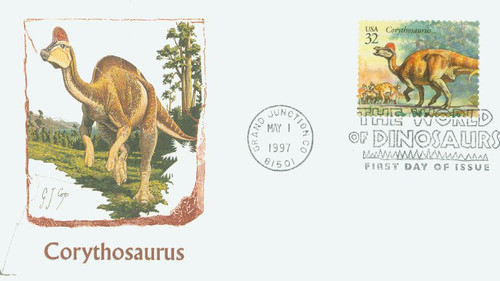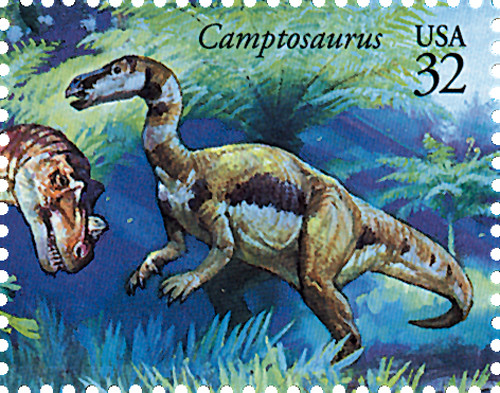
# 3136m - 1997 32c Dinosaurs: Corythosaurus
US #3136m
1997 Corythosaurus – Dinosaurs
- Part of the 2nd US issue picturing dinosaurs (the first being the 1989 block of four)
- Showcases 1 of 7 dinosaurs from the Cretaceous Period pictured on the souvenir sheet
Stamp Category: Commemorative
Value: 32¢, First Class Mail Rate
First Day of Issue: May 1, 1997
First Day City: Grand Junction, Colorado
Quantity Issued: 219,000,000
Printed by: Ashton-Potter (USA) Ltd.
Printing Method: Offset
Format: Panes of 15 (Vertical and horizontal, laid out in 2 irregular groups, 8 in upper group, 7 in lower group)
Perforations: 11.1 x 11
Tagging: Two large tagging blocks, one over the top eight stamps and one over the bottom seven stamps. Tagging follows the odd shape of the perforations.
Why the stamp was issued: Issued in hopes of capturing the attention of young people with a subject they might find interesting.
About the stamp design: Stamp pictures artwork by James Gurney of Rhinebeck, New York (best known as the author and illustrator of the Dinotopia books).
First Day City: The World of Dinosaurs stamps were dedicated in a ceremony at the Museum of Western Colorado’s Dinosaur Valley Museum in Grand Junction, Colorado. Grand Junction is known as the “Dinosaur Triangle” of western Colorado and northeastern Utah. Many dinosaur fossils have been found in the area over the years.
Second Day Ceremony: The second-day ceremony was held on May 2nd at the Berger Dinosaur Hall of the Museum of the Rockies in Bozeman, Montana. Consultant Jack Horner was the main speaker. Horner’s famous long-time rival, Dr. Robert Bakker, had attended the first-day ceremony, making one wonder if, perhaps, Horner had decided not to attend in order to avoid him.
About the World of Dinosaurs set: Originally to be four stamps, Gurney was later asked to do eight designs, then 10, and finally 15. This was partially inspired by complaints USPS had received in the past about wasting paper on big souvenir sheets. Gurney arranged the dinosaurs in two panoramic shots, one representing the Jurassic Period (150 million years ago) and the other representing the Cretaceous (75 million years ago). The artist consulted with famous dinosaur expert Jack Horner as well as Michael Brett-Surman of the Smithsonian, Ken Carpenter of the Denver Museum of Natural History, and Phil Currie of the Royal Tyrell Museum of Paleontology in Alberta, Canada.
In addition to offering suggestions for less-common dinosaur species, Gurney said “The scientists also provided me with lots of information about other creatures that would have shared the world with dinosaurs: frogs, turtles, insects, crocodiles, pterosaurs, mammals, and birds – as well as the plants: sequoias, cycads, tree ferns, and horsetails… Recreating the full texture of this environment was very important to me. Too often, illustrations give the impression that dinosaurs just trotted around on dry lakebeds looking grumpy while a volcano chugged away in the background. In fact, their world was a rich and diverse ecosystem. There were plenty of plants and animals that looked a lot like what you would find today in Florida.”
History the stamp represents: Dinosaurs came in all shapes and sizes during their long evolutionary journey. In heads alone, there was a huge diversity – many sporting unusual lumps, bumps, crests, and bony spikes. Corythosaurus got its name from the helmet-like crest on its head. As a hadrosaur, it was a Late Cretaceous dinosaur, a group distinguished by duckbills and strangely decorated heads.
Corythosaurus was a mid-sized dinosaur, ranging from 18-33 feet long and weighing 2-4 tons. Because it had a pebble-like, armorless skin, these dinosaurs herded with their own kind, relying on keen eyes, ears, and sense of smell of the group for detecting danger. At the warning signal, the group would stampede away, running on two legs as fast as possible.
Like other hadrosaurs, Corythosaurus was a plant eater. And though its duckbill was toothless, it had lots of teeth – in fact, hadrosaurs had more teeth than any other dinosaur group. With their duckbills, they ingested twigs, leaves, and pine needles. As the vegetation moved toward the throat, as many as 200 sharp, diamond-shaped teeth set in multiple rows along the back of their jaws ground the food, much like a modern vegetable grater. Because these teeth would frequently wear down, new ones continually emerged to replace them.
US #3136m
1997 Corythosaurus – Dinosaurs
- Part of the 2nd US issue picturing dinosaurs (the first being the 1989 block of four)
- Showcases 1 of 7 dinosaurs from the Cretaceous Period pictured on the souvenir sheet
Stamp Category: Commemorative
Value: 32¢, First Class Mail Rate
First Day of Issue: May 1, 1997
First Day City: Grand Junction, Colorado
Quantity Issued: 219,000,000
Printed by: Ashton-Potter (USA) Ltd.
Printing Method: Offset
Format: Panes of 15 (Vertical and horizontal, laid out in 2 irregular groups, 8 in upper group, 7 in lower group)
Perforations: 11.1 x 11
Tagging: Two large tagging blocks, one over the top eight stamps and one over the bottom seven stamps. Tagging follows the odd shape of the perforations.
Why the stamp was issued: Issued in hopes of capturing the attention of young people with a subject they might find interesting.
About the stamp design: Stamp pictures artwork by James Gurney of Rhinebeck, New York (best known as the author and illustrator of the Dinotopia books).
First Day City: The World of Dinosaurs stamps were dedicated in a ceremony at the Museum of Western Colorado’s Dinosaur Valley Museum in Grand Junction, Colorado. Grand Junction is known as the “Dinosaur Triangle” of western Colorado and northeastern Utah. Many dinosaur fossils have been found in the area over the years.
Second Day Ceremony: The second-day ceremony was held on May 2nd at the Berger Dinosaur Hall of the Museum of the Rockies in Bozeman, Montana. Consultant Jack Horner was the main speaker. Horner’s famous long-time rival, Dr. Robert Bakker, had attended the first-day ceremony, making one wonder if, perhaps, Horner had decided not to attend in order to avoid him.
About the World of Dinosaurs set: Originally to be four stamps, Gurney was later asked to do eight designs, then 10, and finally 15. This was partially inspired by complaints USPS had received in the past about wasting paper on big souvenir sheets. Gurney arranged the dinosaurs in two panoramic shots, one representing the Jurassic Period (150 million years ago) and the other representing the Cretaceous (75 million years ago). The artist consulted with famous dinosaur expert Jack Horner as well as Michael Brett-Surman of the Smithsonian, Ken Carpenter of the Denver Museum of Natural History, and Phil Currie of the Royal Tyrell Museum of Paleontology in Alberta, Canada.
In addition to offering suggestions for less-common dinosaur species, Gurney said “The scientists also provided me with lots of information about other creatures that would have shared the world with dinosaurs: frogs, turtles, insects, crocodiles, pterosaurs, mammals, and birds – as well as the plants: sequoias, cycads, tree ferns, and horsetails… Recreating the full texture of this environment was very important to me. Too often, illustrations give the impression that dinosaurs just trotted around on dry lakebeds looking grumpy while a volcano chugged away in the background. In fact, their world was a rich and diverse ecosystem. There were plenty of plants and animals that looked a lot like what you would find today in Florida.”
History the stamp represents: Dinosaurs came in all shapes and sizes during their long evolutionary journey. In heads alone, there was a huge diversity – many sporting unusual lumps, bumps, crests, and bony spikes. Corythosaurus got its name from the helmet-like crest on its head. As a hadrosaur, it was a Late Cretaceous dinosaur, a group distinguished by duckbills and strangely decorated heads.
Corythosaurus was a mid-sized dinosaur, ranging from 18-33 feet long and weighing 2-4 tons. Because it had a pebble-like, armorless skin, these dinosaurs herded with their own kind, relying on keen eyes, ears, and sense of smell of the group for detecting danger. At the warning signal, the group would stampede away, running on two legs as fast as possible.
Like other hadrosaurs, Corythosaurus was a plant eater. And though its duckbill was toothless, it had lots of teeth – in fact, hadrosaurs had more teeth than any other dinosaur group. With their duckbills, they ingested twigs, leaves, and pine needles. As the vegetation moved toward the throat, as many as 200 sharp, diamond-shaped teeth set in multiple rows along the back of their jaws ground the food, much like a modern vegetable grater. Because these teeth would frequently wear down, new ones continually emerged to replace them.









